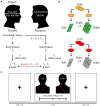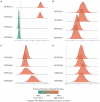Common and distinct equity preferences in children and adults
- PMID: 38420165
- PMCID: PMC10899522
- DOI: 10.3389/fpsyg.2024.1330024
Common and distinct equity preferences in children and adults
Abstract
Fairness plays a crucial role in children's social life and has garnered considerable attention. However, previous research and theories primarily examined the development of children's fairness behaviors in the conflict between self-interest motivation and fairness-complying motivation, neglecting the influence of advantage-seeking motivation. Moreover, despite the well-established role of gain/loss frame in human decision-making, it remains largely unclear whether the framing effect modulates fairness behaviors in children. It was hypothesized that children would exhibit advantage-seeking motivation resulting in more selfish behaviors in the loss context. To examine the hypothesis, we combined an adapted dictator game and computational modeling to investigate various motivations underlying fairness behaviors of children in both loss and gain contexts and to explore the developmental directions by contrasting children and adults. In addition, the current design enabled the dissociation between fairness knowledge and behaviors by asking participants to decide for themselves (the first-party role) or for others (the third-party role). This study recruited a total of 34 children (9-10 years, Mage = 9.82, SDage = 0.38, 16 females) and 31 college students (Mage = 19.81, SDage = 1.40, 17 females). The behavioral results indicated that children behaved more selfishly in first-party and more fairly in third-party than adults, without any significant framing effects. The computational results revealed that both children and adults exhibited aversion to advantageous and disadvantageous inequity in third-party. However, they showed distinct preferences for advantageous inequity in first-party, with advantage-seeking preferences among children and aversion to advantageous inequity among adults. These findings contribute to a deeper understanding of children's social preferences and their developmental directions.
Keywords: advantage-seeking; computational model; fairness; framing effect; inequity aversion.
Copyright © 2024 Xu, Luo, Zhu, Zhao, Zhang, Zhang, Feng and Guan.
Conflict of interest statement
The authors declare that the research was conducted in the absence of any commercial or financial relationships that could be construed as a potential conflict of interest.
Figures






Similar articles
-
The role of social motivation in sharing and fairness: insights from Williams syndrome.J Neurodev Disord. 2024 Aug 31;16(1):50. doi: 10.1186/s11689-024-09568-3. J Neurodev Disord. 2024. PMID: 39217324 Free PMC article.
-
Young Children's Development of Fairness Preference.Front Psychol. 2016 Aug 30;7:1274. doi: 10.3389/fpsyg.2016.01274. eCollection 2016. Front Psychol. 2016. PMID: 27625616 Free PMC article.
-
Win-win or lose-lose: Children prefer the form of equality.Acta Psychol (Amst). 2024 Jun;246:104251. doi: 10.1016/j.actpsy.2024.104251. Epub 2024 Apr 15. Acta Psychol (Amst). 2024. PMID: 38626598
-
The Influence of Emotion on Fairness-Related Decision Making: A Critical Review of Theories and Evidence.Front Psychol. 2017 Sep 19;8:1592. doi: 10.3389/fpsyg.2017.01592. eCollection 2017. Front Psychol. 2017. PMID: 28974937 Free PMC article. Review.
-
Children's Sense of Fairness as Equal Respect.Trends Cogn Sci. 2019 Jun;23(6):454-463. doi: 10.1016/j.tics.2019.03.001. Epub 2019 Apr 2. Trends Cogn Sci. 2019. PMID: 30952599 Review.
References
LinkOut - more resources
Full Text Sources

